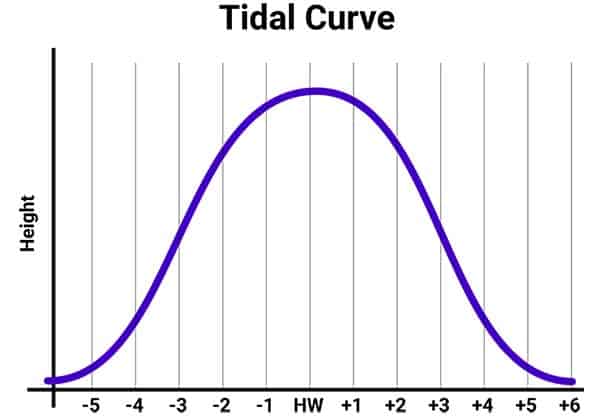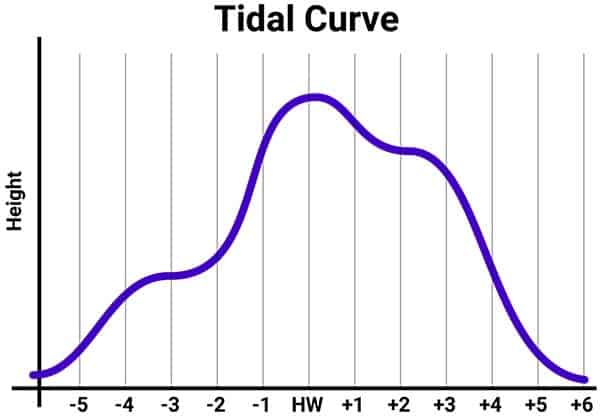When Is Slack Tide?
Slack tide refers to the time period where the tide appears to neither be rising nor falling. Literally, the water is slack.
Slack tide occurs from approximately 30 minutes before high or low water, until 30 minutes after. In areas that experience double high or low water, slack tide occurs more frequently, around all of the points where the tidal curve is flat.
Most of the world experiences two high-waters, and two low-waters each day.
Around the time of high-water (or low-water) the tide is barely moving and can be considered slack. It does not appear to be rising or falling.
Although 30 minutes on either side of high water is a good rule-of-thumb, in reality, it does vary depending on the tidal range in your location.
When you look at a tidal graph, you can see slack water as the point where the curve of the graph is the flattest.
In areas with a large tidal range, slack water is shorter.

In areas with a smaller tidal range, slack water is longer.

Similarly, in areas where the tidal curve does not follow a typical sinusoidal pattern, slack water occurs any time when the tidal curve appears flat. This is particularly the case in areas with double high water.

Consulting the tidal curve for a local area is the best way of working out when slack water occurs, however you should also take note of local considerations such as rainfall, which may impact when slack water occurs.
What influences the time of slack water?
By definition, slack water is the time when the movement of water is the least.
In most areas, water movement is driven by the tide, so slack water occurs when the effect from the tide is the least.
Generally, this happens around the times of high water or low water, or other times when the tidal curve flattens out.
The tide, however, is not the only driver of water movement.
Pro Tip: Slack Tide is just one of the tides that I explain in this article: 20 Types of Tide: Explained By A Real Ship’s Officer.
How rivers influence the time of slack water
If there is a river feeding into your area, slack water will occur when the influence of the tide balances out the influence from the river.
There is always a flow of water coming down the river, so you need the tide to cancel out that flow for the water to be slack.
If there is no tidal influence to counter the flow from a river, the water will never be slack.
How rainfall influences the time of slack water
Rainfall can influence the time of slack water when it causes a water flow by itself.
This is most common in rivers, where the flow from the river is affected by the amount of rainfall throughout the river basin.
Again, slack water will simply occur at the time when the effect of the tide cancels out the effect of rainfall.
Explaining slack water with the rule of 12ths
Having established that slack water occurs when there is no water movement, we can estimate the time of slack water without even looking at a tidal curve.
We can use the rule of 12ths, which is a good approximation of a sinusoidal curve that can be broken down into 12 segments.
For tides, where we have 6 hours before high water, and 6 hours after high water, we can use the rule of 12ths to approximate the amount of movement across each hour.
| Time | Change In Water Level |
|---|---|
| LW to HW -5 | 1/12 |
| HW -5 to HW -4 | 2/12 |
| HW -4 to HW -3 | 3/12 |
| HW -3 to HW -2 | 3/12 |
| HW -2 to HW -1 | 2/12 |
| HW -1 to HW | 1/12 |
| HW to HW +1 | 1/12 |
| HW +1 to HW +2 | 2/12 |
| HW +2 to HW +3 | 3/12 |
| HW +3 to HW +4 | 3/12 |
| HW +4 to HW +5 | 2/12 |
| HW +5 to LW | 1/12 |
You can see that in the hour before high water, and the hour after high water, the tide only moves by approximately 1/12th of its entire range.
In areas with a small tidal range, 1/12th of that range is going to be small enough that you will barely notice any movement, so you could say that the water is slack.
In areas with a greater tidal range, 1/12th of that range will still be significant.
So, instead of taking 1 hour before high water, we look at 30 minutes before high water to estimate the time of slack water.
Why do you need to know the time of slack water?
In my experience, I need to know the time of slack water because it is the time when ship handling is the easiest.
Essentially, during slack water, the current has a minimal effect on a boat or ship.
In fact, boaters need to know a lot of information about tides because they have such an effect on so many different aspects of boating.
Read more in this article: How Do Tides Affect Boats?
Boaters, however, are not the only people that need to know about the time of slack water.
- Swimmers need to know the time of slack water as it is the safest time to swim.
- Fishing enthusiasts need to know the time of slack water as it can be the best (or worst) time to fish, depending on the species you are looking for.
- Divers need to know the time of slack water as it can be the time when underwater visibility is the best.
- Scientists need to know the time of slack water as it is the easiest time to place scientific instruments into the seabed.
